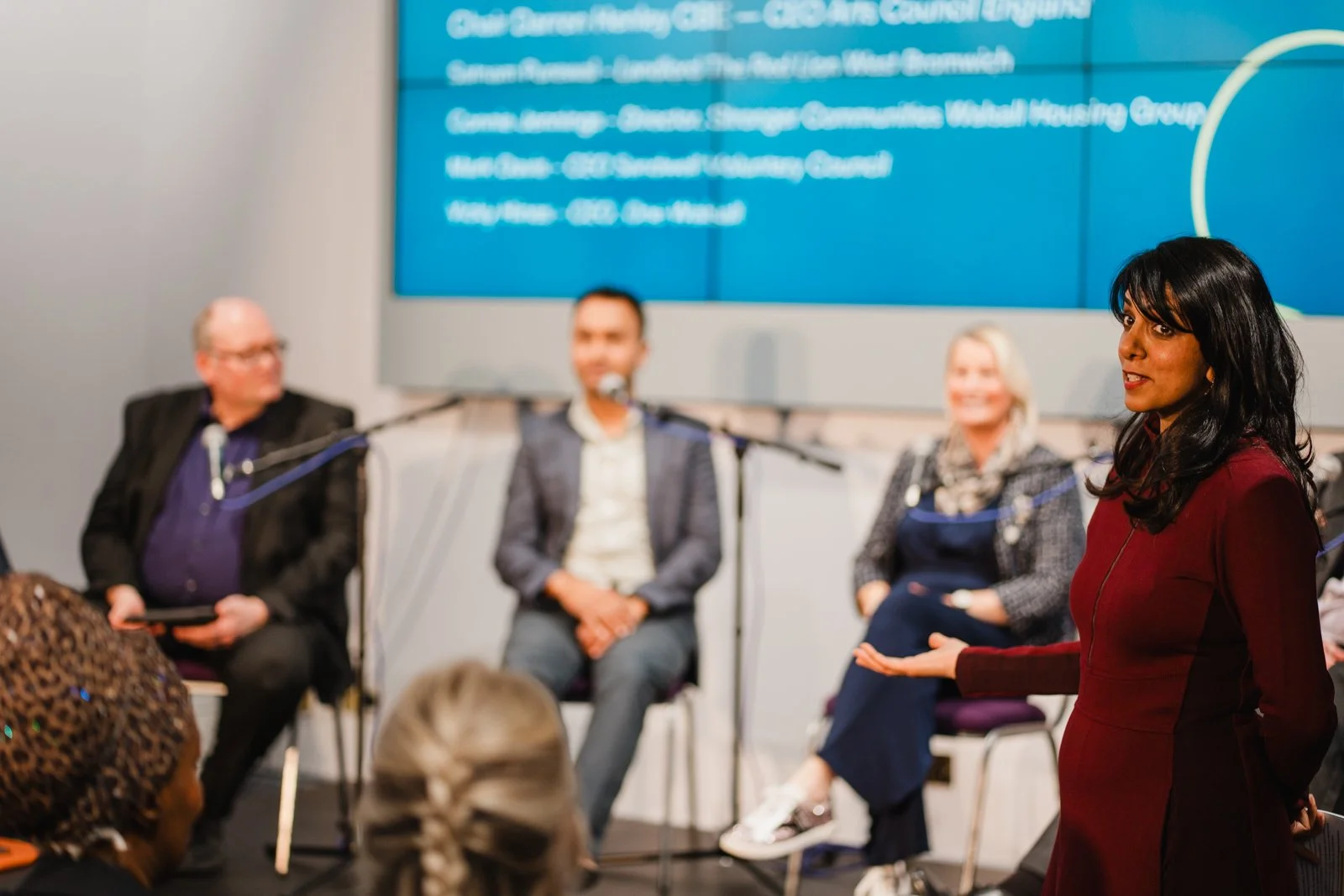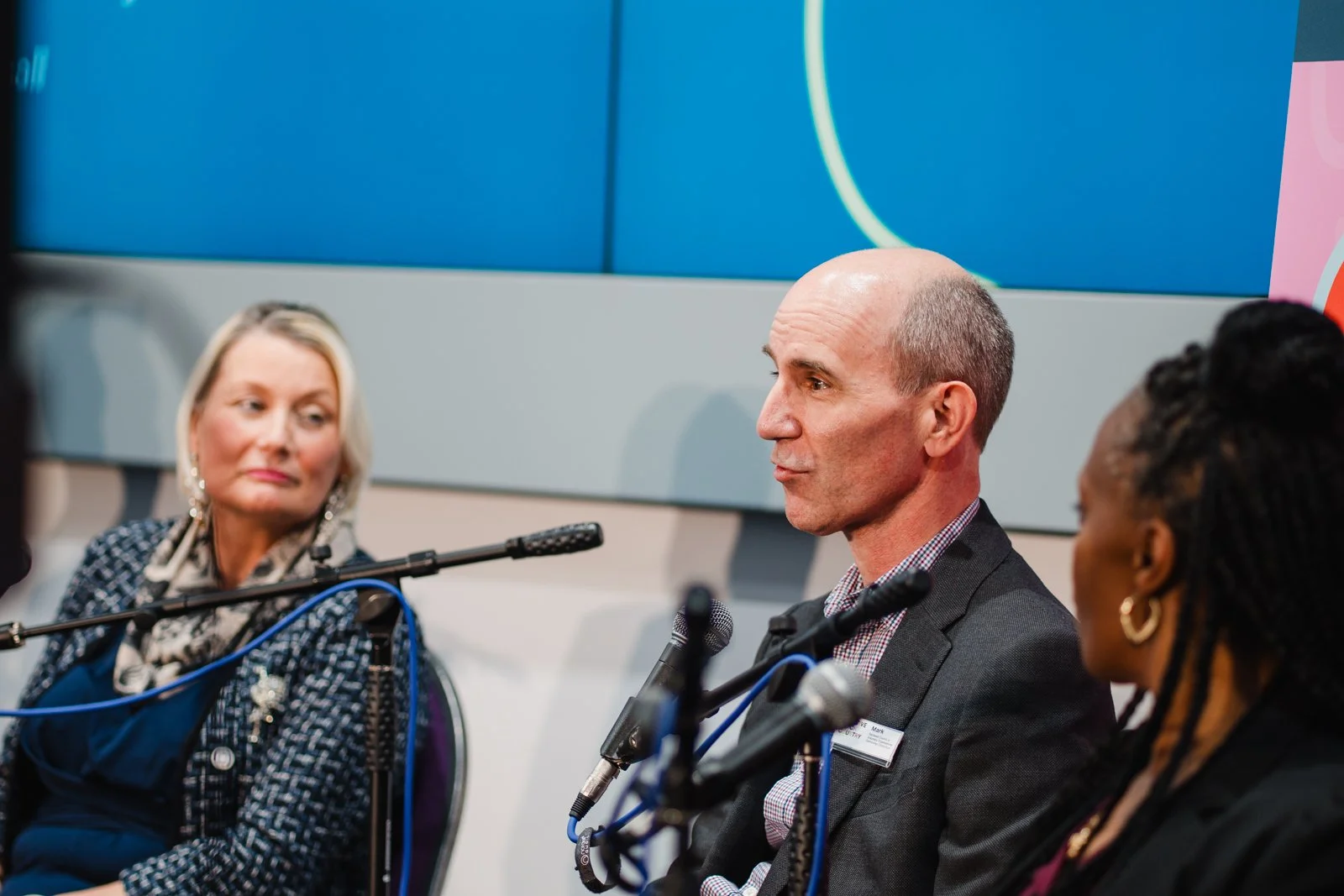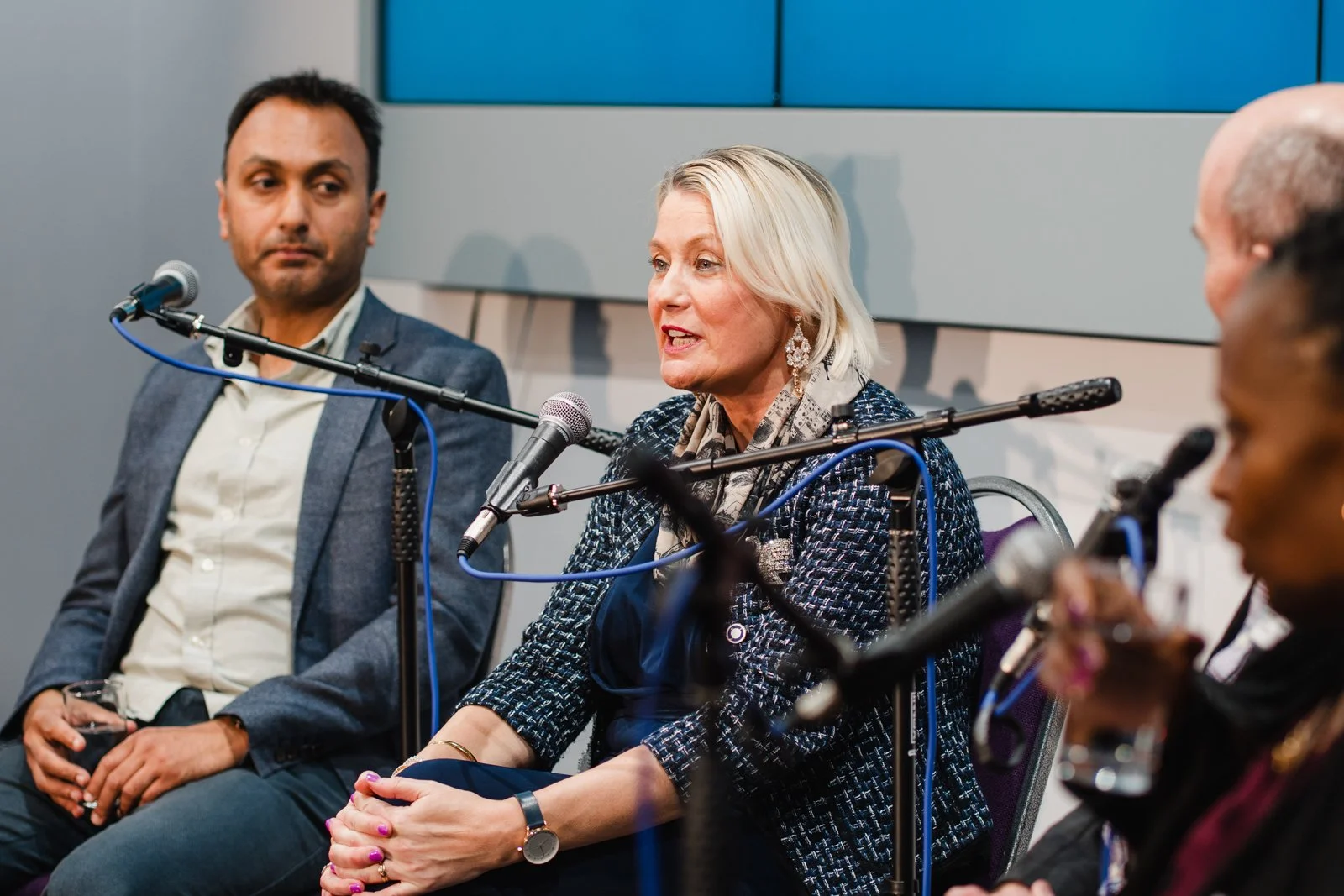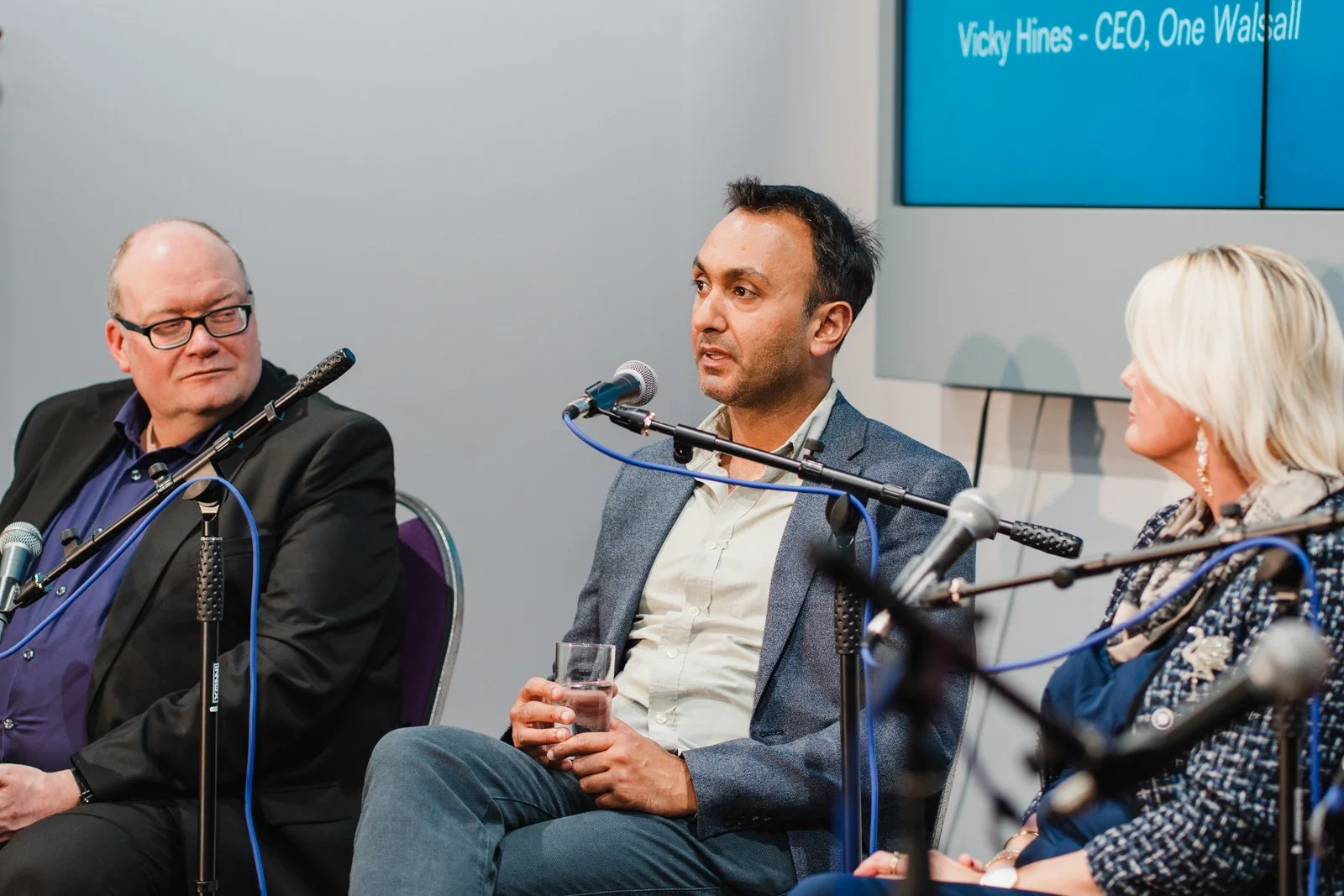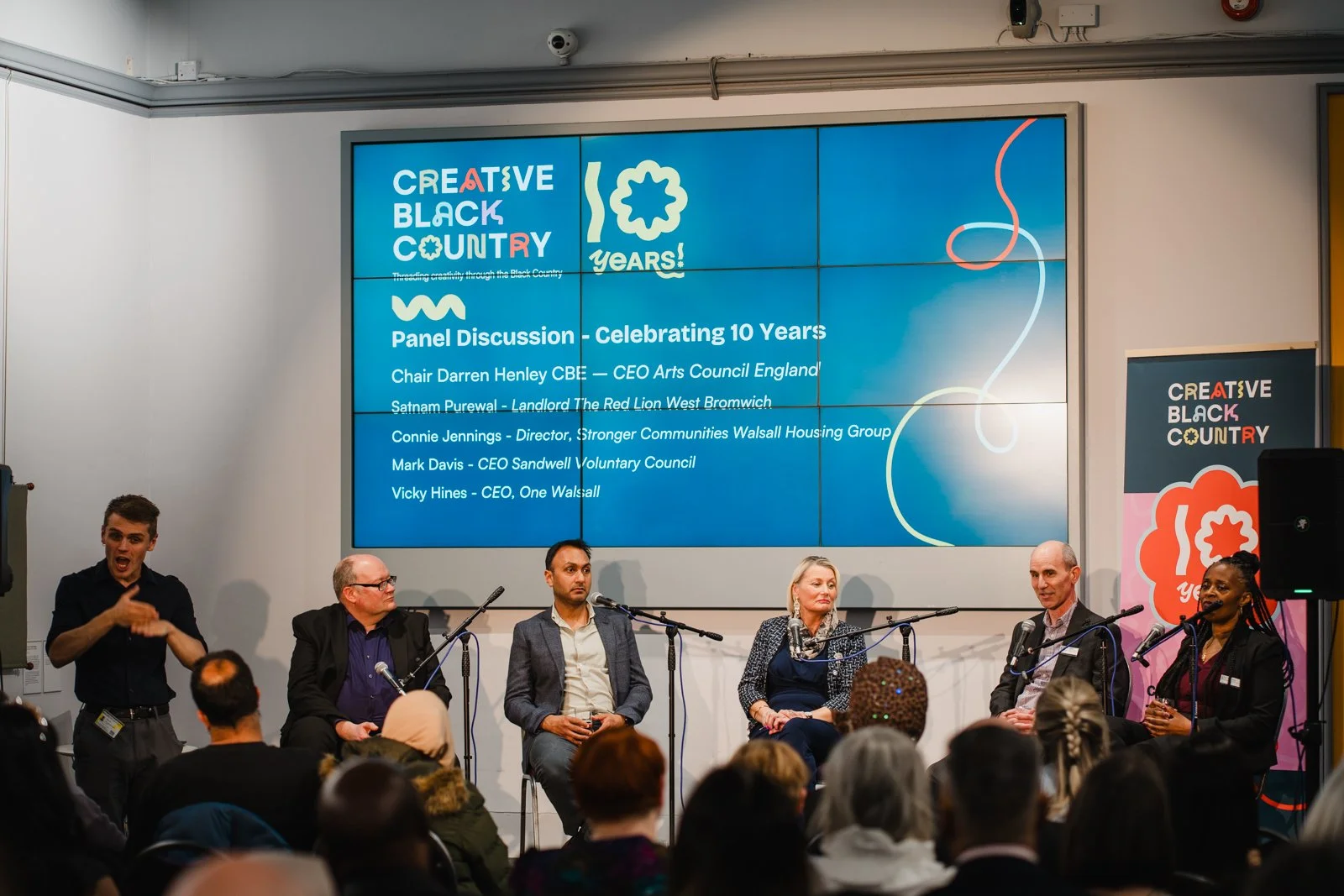Celebrating 10 Years of Creativity and Community - highlights from the panel discussion
Capturing the panel - Image by Lee Allen
At Creative Black Country’s 10-year anniversary event, a panel of partners and community leaders came together to reflect on a decade of impact. The conversation was lively, honest, and full of pride for how far the region has come — and how much further it can still go.
The panel included:
Chair Darren Henley CBE – CEO Arts Council England
Satnam Purewal - Landlord The Red Lion West Bromwich - representing the Desi Pub landlord group
Connie Jennings - Director, Stronger Communities Walsall Housing Group - partner for our artist residency and Walsall Makes
Mark Davis - CEO Sandwell Voluntary Council - part of our Consortium Partnership
Vicky Hines - CEO, One Walsall - part of our Consortium Partnership
Creative Director, Parminder shares the backstory and some of the numbers - image by Lee Allen
Getting started
While we know numbers don’t tell the full story of a programme this complex just to give some context Sajida and Parminder shared some background of our 10 year journey including some impressive stats:
Delivering over 2,500 creative events
Engaging 2.2 million people
Working with nearly 40,000 participants
Facilitating over 10,000 hours of creative activity
Securing and investing over £5.5 million into arts and culture
Bringing People Together
Vicky Hines - CEO, One Walsall (pictured with Mark Davis) - image by Lee Allen
Vicky opened the discussion by highlighting the power of connection and reflecting on Creative Black Country’s support in helping to bring Walsall’s Creative Compact together.
“The [Walsall] Compact was an opportunity to bring the creative, artistic, and cultural sectors together, but also key partners,” she said. “It’s been very exciting to bring all those different elements together. In Walsall, we have a really varied sector — creatives who do the work but also community groups who probably don’t even tag what they do as art, creativity or culture. They just get on with it.”
She emphasised the importance of reaching underserved, underrepresented communities, making sure that creativity is accessible to everyone. “It’s about how we can bring people to the table — and it’s for everyone. It’s really exciting to be part of that.”
Mark Davis, CEO of SCVO has been part of the Creative Black Country story from the start
A Decade of Growth
Mark, who has been involved since the programme’s inception as SCVO’s CEO, shared his reflections on the journey.
“It’s been really interesting and a lot of fun,” he said. “It’s been a real joy to see and hear all the things that have been achieved by so many people. The numbers that Sajida and Parminder shared earlier are just astounding.”
He credited the long-term support they received via Arts Council England’s Creative People and Places Programme as well as partner support, which allowed the team to take creative risks.
“We’ve learned from each other — the voluntary sector, the arts and cultural sector. One of the words I used to describe the impact was ‘eye-opening.’ All the organisations have played a part in different ways.”
Connie Jennings - Director, Stronger Communities Walsall Housing Group is an advocate of arts provision in communities - Image by Lee Allen
Art Where You Live
Connie spoke passionately about embedding an artist into the whg social housing wellbeing scheme — a project that shifted perspectives for residents who previously felt art wasn’t "for them."
“Due to deprivation and poverty, our customers don’t see things like art as accessible,” she explained. “Having an artist in residence has provided access to something they probably only dreamed about — something they’d been looking over the fence at, thinking ‘that’s for posh people.’”
By bringing creativity into a familiar environment, barriers fell away. “I’ve observed the groups working with the artists — the vibe, the energy, the positivity have been amazing. We even took residents to London — and for some, it was their first time ever leaving Walsall. It’s been great seeing art speak for people.”
When asked what cultural organisations could learn about being more welcoming and accessible, Connie didn’t hold back: “Creative Black Country push boundaries. We worked with Laura Dicken (Creative Black Country’s Associate Producer and Creative Adviser) - she could work in my team — she’s empathetic, considerate about learning. Art doesn’t have to be elitist. It can be making a cake with your grandchild. Using art as an enabler to drive social mobility has been really important and successful for us.”
Satnam shares the impact of creativity on Desi Pubs - Image by Lee Allen
Keeping city and town centres alive with art in unexpected places
The conversation then turned to the challenges facing city and town centres.
“City centres have died,” said Satnam sharing the state that many of our local areas are facing. “The things driving people into the city are the arts and hospitality. Without those two, the city centre would be dead.”
But both sectors are under threat, he warned, facing funding cuts and rising costs. Supporting arts and hospitality is essential if cities are to thrive.
Satnam also took the audience back to when the idea of putting art into pubs first surfaced. “If you live in London or Manchester, you engage with art. If you live in Sandwell, you don’t necessarily,” he said. “So the idea was, let’s take art to places where people wouldn’t expect it.”
Each Desi pub in the project hosted a different piece of art — stained glass, mosaics, photography — telling the story of the Punjabi community’s arrival in Sandwell. “People come into the pub and look at it — these pieces of art are absolutely stunning. They tell a story, and good art always does.”
Darren Henley, CEO of Arts Council England chaired the panel and made the case for everyone to share their creative journey - Image by Lee Allen
Shout it out loud - a call to action from the CEO of Arts Council England
Darren was asked by the audience how we preserve arts funding. A subject close to everyone who attended the event. He had a message for those in power who hold the budgets in government.
“I think art is a necessity not a luxury, so I think that is the case that we make…” He told the audience. “People who are passionate about culture whose lives have been touched by it, we need you to talk about it!”
He suggested that local people make sure that their local MPs (two of which were in the audience on the night) know how important arts funding and provision is.
Parminder, Darren, Sathnam, Connie, Mark, Vicky and Sajida - Image by Lee Allen
The last word goes to…
Connie summed up the mood of the Black Country perfectly: “Black Country people are really resilient they make something out of nothing and don’t expect a lot, so when they get something they really value it I think. For me, the arts are such an important aspect of our lives because that’s what makes us human.
In terms of stories I’ve been really keen to use our artist in residence to create stories of home because home is what anchors us. And to create stories of the older generations that are working class because history tends to be about upper class or middle class people, rather than the working class people that build the country. So, for me, having access to an artist who can talk to customers and create their own stories about where they live, why they live there, what they’re proud about, what they’d change, what they don’t want people to forget; I think is really important.”
“What I like about Creative Black Country is that they make art real, for real people and that’s really important to me… the reason that we work with Creative Black Country is that they are a values led organisation, they care about the people, they care about who they work with, they care about the product, they care about quality, they care about safeguarding the people that we work with.”
The audience at the discussion - Image by Lee Allen
Thank you to everyone that came along and took part in the discussion.


